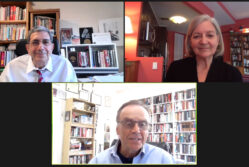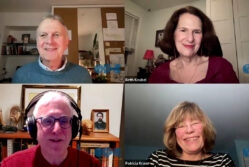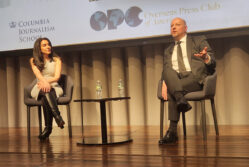
Expert Panelists Discuss Reporter-Embassy Relations
Professional relations between diplomats and foreign correspondents are thorny. The two sides are in some ways dependent on each other, but the relationship is also fraught with suspicion and tension.
On Nov. 11, the OPC convened experts to address some of the day-to-day challenges of such relationships during a panel titled “Useful Sources: What Should Be the Relationships of Reporters to Diplomats, Especially in Times of Crisis?” Newsweek and The Daily Beast contributor Allan Dodds Frank moderated.
The session was pitched at newly assigned correspondents who are not yet familiar with embassy protocols.
Dale Prince, director of the New York Foreign Press Center, kicked off the discussion with a primer on the responsibilities of a State Department press officer.
Prince said the “mutually beneficial exchange” between press officer and reporter “is only possible with trust and ground rules.”
Press liaisons are responsible for answering reporters’ questions truthfully, he said, and for timely responses to requests. They are not responsible for answering questions that should be directed at other branches of government, and can’t comment on intelligence or military operations. He referred to a set of ground rules published by the State Department that clearly define differences between terms like “on record” and “on background” interviews.
- A Responsible Press Office in the Digital Age
- Ground Rules for Interviewing State Department Officials
Seymour Topping, and former correspondent for the New York Times and the Associated Press, author and OPC board member, recounted a story from his reporting in which a Chinese diplomat asked him to write a story about China’s willingness to divide North and South Vietnam. China had no formal diplomatic relations with the U.S. at the time, so his article was used as a back channel, he said.
“That’s an example, of course, where you can do your job and make a contribution to the world at large,” he told attendees.
Edith Lederer, a longtime Associated Press correspondent, contrasted her experience as a correspondent during the Vietnam War, when reporters could secure near limitless jump seats in helicopters to cover the country, with that of the First Gulf War in Kuwait, when interviews with soldiers were not allowed, information was tightly controlled and reports censored.
“What we have seen in my lifetime as a war correspondent and a foreign correspondent, have been much greater attempts to control the message that the U.S. government wants to send out.”
She recalled sneaking into Afghanistan in 1979 and contacting the U.S. Embassy to make sure someone knew she was in the country. She added that non-U.S. embassies can also become key resources. Later when civil war had broken out in Afghanistan, the Turkish embassy kept track of the whereabouts of all foreign journalists and became “a kind of protector.”
“If you didn’t show up or call to say you were delayed, they would go and look for you,” she said.
Lindsay Krasnoff, historian of the State Department, spoke about the development of relations between reporters and embassies during World War I. The two sides grew close because of journalists’ reliance on diplomatic transportation to get to the front, and the embassy’s reliance on reports from journalists who went to locations they couldn’t go.
“There was certain trust on the part of U.S. diplomats that the information that they gave the journalists who visited them, and on the other side there was certain restraint and self-censorship on the side of journalists to maintain the diplomat’s trust in terms of not publishing all that they witnessed,” until the information became less sensitive she said.
To read more about the history of U.S. diplomats during World War I, see links below:
- “Views From the Embassy,” an article about the experience of U.S. diplomats, consuls, and their families during the first months of the war.
- U.S. Embassy Paris’ World War One Centenary
- A blog post on the subject by Krasnoff
Andrew Nagorski, author and former Newsweek correspondent, recalled examples from his personal experience covering Southeast Asia and working as bureau chief for Newsweek in Russia, where he was expelled in 1982.
Nagorski remembered meeting a CIA agent who gave him battlefield intelligence on deep background in exchange for a pair of jogging shoes. He said it was clear that the U.S. embassy wanted to get the story released without implicating Washington, and as a reporter he found the level of detail irresistible. His story, and the other stories from the evening, illustrated the push and pull felt by every reporter depending on diplomatic sources.
“We’ve seen a range here, starting with the issue of trust, and then the issue of tension, and both are inherent in any relationship between journalists and diplomats,” Nagorski said.



